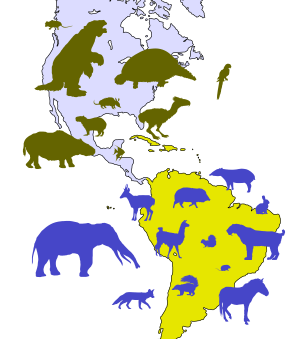Central American Seaway
The Central American Seaway, also known as the Panamanic Inter-American and Proto-Caribbean Seaway, was a body of water that once separated North America from South America. It formed in the Mesozoic (200–154 Ma) during the breakup of the supercontinent Pangaea, and closed when the Isthmus of Panama was formed by volcanic activity in the late Pliocene (2.76–2.54 Ma).

The closure of the Central American Seaway had tremendous effects on oceanic circulation and the biogeography of the adjacent seas, isolating many species and triggering speciation and diversification of tropical and sub-tropical marine fauna.[1] The inflow of nutrient-rich water of deep Pacific origin into the Caribbean was blocked, so local species had to adapt to an environment of lower productivity.[2] It had an even larger impact on terrestrial life. The seaway had isolated South America for much of the Cenozoic, allowing the evolution of a wholly unique diverse mammalian fauna there; when it closed, a faunal exchange with North America ensued, leading to the extinction of many of the native South American forms.[3][4]
Evidence
The evidence for when the Central American landmass emerged and the closing of the Central American Seaway can be divided into three categories. The first is the direct geologic observation of crustal thickening and submarine deposits in Central America. The second is the Great American Interchange of vertebrates between North and South America which required a continuous land bridge across the two areas for the organisms to travel along with a climate that was very different from the climate today. Lastly is the development of differences in marine assemblages and their isotopic signatures in the Caribbean from those in the Pacific.[5][6] The Central American Seaway was closed by the elevation of the Central American Isthmus which is proposed to have occurred three and a half to five million years ago. The closing of the Central American Seaway is also supported by the evolution of taxa on different sides of the Central American Isthmus along with the different histories of the oceans on either side of the isthmus.
Consequences
The closing of the seaway allowed a major migration of land mammals between North and South America, known as the Great American Interchange. This allowed species of mammals such as cats, canids, horses, elephants and camels to migrate from North America to South America, while porcupines, ground sloths, glyptodonts and terror birds made the reverse migration. There is much controversy about glacial and interglacial climates in South America. Research shows that vegetation in most of the Amazon basin has changed very little since glacial times, although it is believed there was more savanna present during that period. A closed seaway would have led to a very different North Atlantic Ocean circulation, impacting the surrounding atmospheric temperatures, which in turn affected the glacial cycle. The emergence of the isthmus caused a reflection of the westward-flowing North Equatorial Current northward and enhanced the northward-flowing Gulf Stream.[7] The Pacific coast of South America would have cooled as the input of warm water from the Caribbean was cut off. This trend is thought to have caused the extinction of the marine sloths of the area.[8]
The closure of the seaway led to an increased poleward salt and heat transport, strengthening the North Atlantic thermohaline circulation 2.95–2.82 million years ago, in turn increasing moisture supply to Arctic latitudes, contributing to both Arctic continental glaciation and sea ice formation, and eventually—with the orbitally paced extension of Gelasian ice sheets—the Quaternary ice age.[9]
See also
- Atlantic meridional overturning circulation – system of currents in the Atlantic Ocean, having a northward flow of warm, salty water in the upper layers and a southward flow of colder, deep waters that are part of the thermohaline circulation
- Great American Interchange – Paleozoographic event resulting from the formation of the Isthmus of Panama
- North Atlantic Deep Water – deep water mass formed in the North Atlantic Ocean
- Paleoceanography – The study of the history of the oceans in the geologic past
References
- Lessios, H.A. (December 2008). "The Great American Schism: Divergence of Marine Organisms After the Rise of the Central American Isthmus". Annual Review of Ecology, Evolution, and Systematics. Palo Alto. 39: 63–91. doi:10.1146/annurev.ecolsys.38.091206.095815. S2CID 33313323.
- Jain, S.; Collins, L. S. (2007-04-30). "Trends in Caribbean Paleoproductivity related to the Neogene closure of the Central American Seaway". Marine Micropaleontology. 63 (1–2): 57–74. Bibcode:2007MarMP..63...57J. doi:10.1016/j.marmicro.2006.11.003.
- Simpson, George Gaylord (1980). Splendid Isolation: The Curious History of South American Mammals. New Haven: Yale University Press. p. 266. ISBN 0-300-02434-7. OCLC 5219346.
- Marshall, L. G. (July–August 1988). "Land Mammals and the Great American Interchange" (PDF). American Scientist. 76 (4): 380–388. Bibcode:1988AmSci..76..380M. Archived from the original (PDF) on 2013-03-02. Retrieved 2014-04-22.
- "Archived copy" (PDF). Archived from the original (PDF) on 2015-09-21. Retrieved 2015-12-07.CS1 maint: archived copy as title (link)
- Molnar, Peter. "Closing of the Central American Seaway and the Ice Age: A critical review" (PDF). Archived from the original (PDF) on 2015-09-21.
- "Tertiary Period | geochronology". Encyclopædia Britannica. Retrieved 2015-12-07.
- Amson, E.; Argot, C.; McDonald, H. G.; de Muizon, C. (2015). "Osteology and functional morphology of the axial postcranium of the marine sloth Thalassocnus (Mammalia, Tardigrada) with paleobiological implications". Journal of Mammalian Evolution. 22 (4): 473–518. doi:10.1007/s10914-014-9280-7.
- Bartoli, G.; Sarnthein, M.; Weinelt, M.; Erlenkeuser, H.; Garbe-Schönberg, D.; Lea, D. W. (30 August 2005). "Final closure of Panama and the onset of northern hemisphere glaciation". Earth and Planetary Science Letters. 237 (1): 33–44. Bibcode:2005E&PSL.237...33B. doi:10.1016/j.epsl.2005.06.020. ISSN 0012-821X.